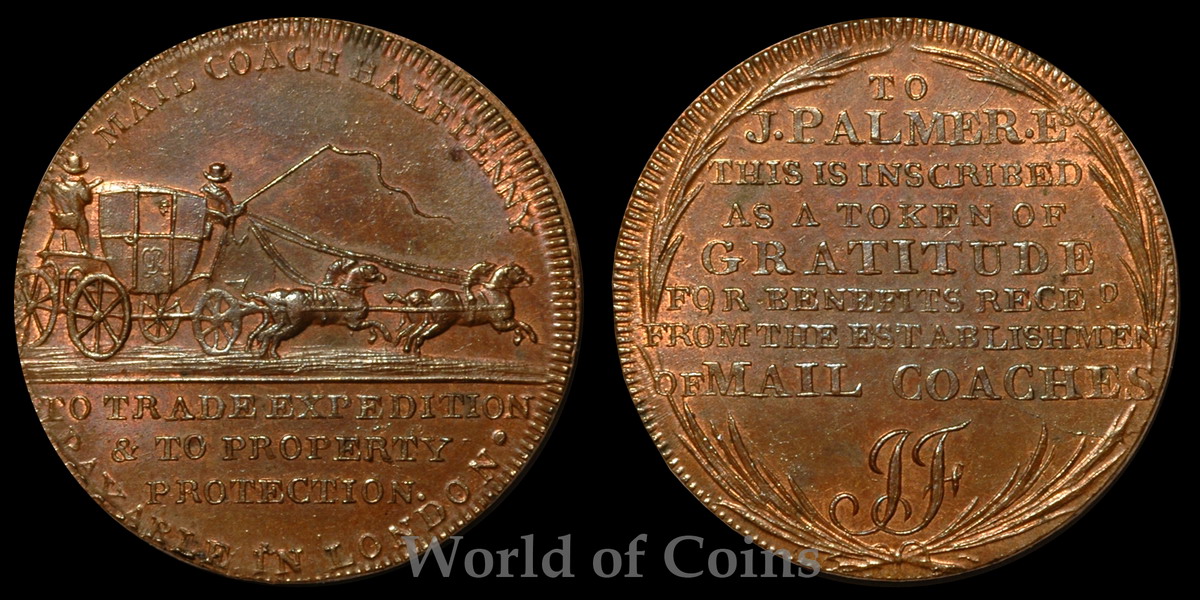
Online collections
monedastodas.com
All collections » Tokens » Mail Coach Halfpenny
The front side depicts a mail wagon drawn by four horses. Above the image is the inscription: "MAIL COACH HALFPENNY". Text at the bottom: "TO TRADE EXPEDITION / & TO PROPERTY / PROTECTION, PAYABLE IN LONDON".

On the reverse side there is an
inscription framed by a wreath: “TO J. PALMER. E / THIS IS
INSCRIBED / AS A TOKEN OF / GRATITUDE / FOR BENEFITS RECEd / FROM THE
ESTABLISHMENT / OF MAIL COACHES / JF".
Dalton & Hamer: 363
Smooth edge.
Engraver - Wyon, manufacturer - Mind.
The commissioner of this issue is unknown, but it may have been London engraver James Fittler, who also dedicated his engraving to Palmer with the words: To John Palmer Esq' Surveyor and Comptroller General of the Post Office: This Plate of the MAIL COACH is respectfully Inscribed By his obedient humble Servant, James Fittler.
 Post
stagecoach. Engraving by James Fittler after a painting by George
Robertson
Post
stagecoach. Engraving by James Fittler after a painting by George
RobertsonHorse-drawn carts were still in the days of the Persian king Cyrus II the Great (c. 593 - 530 BC). For the first time, mail carts were used by the Hansa trade and economic union at the beginning of the 13th century, while in England letters were transmitted with the help of royal messengers. King Edward IV (Edward IV 1461-1483) organized a regular message of messengers on horseback, and Henry VIII (Henry VIII 1491-1547) improved the postal service and organized the service of Postal Masters (Master of the Postes). In the 17th century, mail was still carried in messenger bags at an average speed of 5 miles per hour in winter and 7 miles per hour in summer.
 John
Palmer, 1793. Pencil Drawing by
John
Palmer, 1793. Pencil Drawing byJohn Palmer was born in Bath, Somerset, and after receiving his education began to help his father in the theatrical business. He used stagecoaches to transport sets and actors, and it was this concept that he thought could be used in mail delivery. He suggested that the government deliver mail in carriages drawn by four horses with an armed guard. Horse carriages and coachmen could be provided by numerous contractors throughout the country. The Postmaster General was opposed to the idea, but Prime Minister William Pitt Jr., at Palmer's expense, allowed an experiment to be carried out to deliver mail from Bristol to London. On August 2, 1784, the first post stagecoach left the Rammer Tavern in Bristol and, following through Bath, arrived at the Swan with Two Necks in Lad Lane in London, spending 16 hours on the road, which was a day faster,
After that, the government gave permission to build a network of postal routes between major cities throughout the country, and John Palmer was appointed Chief Postal Inspector. In 1793, Palmer, due to a conflict with the Postmaster General Lord Walsingham, was forced to resign. He died in 1818.